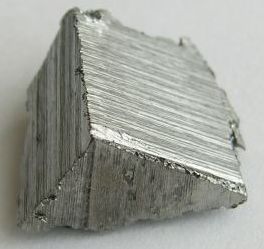
Erbium is a chemical element; it has symbol Er and atomic number 68. A silvery-white solid metal when artificially isolated, natural erbium is always found in chemical combination with other elements. It is a lanthanide, a rare-earth element, originally found in the gadolinite mine in Ytterby, Sweden, which is the source of the element's name.
The lanthanide or lanthanoid series of chemical elements comprises at least the 14 metallic chemical elements with atomic numbers 57–70, from lanthanum through ytterbium. In the periodic table, they fill the 4f orbitals. Lutetium is also sometimes considered a lanthanide, despite being a d-block element and a transition metal.

An iodate is the polyatomic anion with the formula IO−3. It is the most common form of iodine in nature, as it comprises the major iodine-containing ores. Iodate salts are often colorless. They are the salts of iodic acid.

Periodate is an anion composed of iodine and oxygen. It is one of a number of oxyanions of iodine and is the highest in the series, with iodine existing in oxidation state +7. Unlike other perhalogenates, such as perchlorate, it can exist in two forms: metaperiodateIO−
4 and orthoperiodateIO5−
6. In this regard it is comparable to the tellurate ion from the adjacent group. It can combine with a number of counter ions to form periodates, which may also be regarded as the salts of periodic acid.

Sodium periodate is an inorganic salt, composed of a sodium cation and the periodate anion. It may also be regarded as the sodium salt of periodic acid. Like many periodates, it can exist in two different forms: sodium metaperiodate (formula NaIO4) and sodium orthoperiodate (normally Na2H3IO6, but sometimes the fully reacted salt Na5IO6). Both salts are useful oxidising agents.

A lanthanocene is a type of metallocene compound that contains an element from the lanthanide series. The most common lanthanocene complexes contain two cyclopentadienyl anions and an X type ligand, usually hydride or alkyl ligand.
Erbium(III) fluoride is the fluoride of erbium, a rare earth metal, with the chemical formula ErF3. It can be used to make infrared light-transmitting materials and up-converting luminescent materials.
The iodate fluorides are chemical compounds which contain both iodate and fluoride anions (IO3− and F−). In these compounds fluorine is not bound to iodine as it is in fluoroiodates.
Borate phosphates are mixed anion compounds containing separate borate and phosphate anions. They are distinct from the borophosphates where the borate is linked to a phosphate via a common oxygen atom. The borate phosphates have a higher ratio of cations to number of borates and phosphates, as compared to the borophosphates.
Erbium compounds are compounds containing the element erbium (Er). These compounds are usually dominated by erbium in the +3 oxidation state, although the +2, +1 and 0 oxidation states have also been reported.
Iodate sulfates are mixed anion compounds that contain both iodate and sulfate anions. Iodate sulfates have been investigated as optical second harmonic generators, and for separation of rare earth elements. Related compounds include the iodate selenates and chromate iodates.

Erbium(III) selenate is an inorganic compound, with the chemical formula Er2(SeO4)3. It exists as an anhydrate or an octahydrate.
Neodymium(III) iodate is an inorganic compound with the chemical formula Nd(IO3)3.
Thulium iodate is an inorganic compound with the chemical formula Tm(IO3)3. It can be prepared by the hydrothermal reaction of periodic acid and thulium periodate in water at 160 °C. Its crystals can also be crystallized in boiling nitric acid. Its solubility in water is 1.467±0.001 (25 °C, 103 mol·dm−3). Adding dimethyl sulfoxide to water will reduce the solubility.
Ytterbium(III) iodate is an inorganic compound with the chemical formula Yb(IO3)3. Its dihydrate can be prepared by reacting ytterbium sulfate and iodic acid in water at 200 °C. It crystallizes in the P21/c space group, with unit cell parameters a=8.685, b=6.066, c=16.687 Å, β=115.01°.
Gadolinium iodate is an inorganic compound with the chemical formula Gd(IO3)3. It is produced by reacting gadolinium metal with periodic acid at 180 °C. Its solubility in water is 0.893±0.002 (25 °C, 103 mol·dm−3). Adding ethanol or methanol to water will reduce the solubility.
Terbium(III) iodate is an inorganic compound with the chemical formula Tb(IO3)3. It can be obtained by the reaction of terbium(III) periodate and periodic acid in water at 160 °C, or by the hydrothermal reaction of terbium(III) nitrate or terbium(III) chloride and iodic acid at 200 °C. It crystallizes in the monoclinic crystal system, with space group P21/c and unit cell parameters a=7.102, b=8.468, c=13.355 Å, β=99.67°.
Dysprosium iodate is an inorganic compound with the chemical formula Dy(IO3)3. It can be obtained by the reaction of dysprosium nitrate or dysprosium chloride and iodic acid at 200 °C. It exists in two crystal forms: α-form and β-form. Its solubility in water is 1.010±0.001 (25 °C, 103 mol·dm−3). Adding ethanol or methanol to water will reduce the solubility.
Holmium iodate is an inorganic compound with the chemical formula Ho(IO3)3. It can be obtained by reacting holmium periodate and periodic acid in water at 170 °C. Its solubility in water is 1.162±0.001 (25 °C, 103 mol·dm−3). Adding ethanol or methanol to water will reduce the solubility.
Samarium iodate is an inorganic compound with the chemical formula Sm(IO3)3.





